|
fashion: feature
 Donna Loveday: unravelling the mystique Donna Loveday: unravelling the mystique
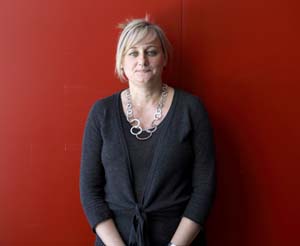
Jack Yan
interviews Donna Loveday,
the senior curator from the Design Museum behind When Philip Met
Isabella, on Philip Treacy’s
hats for Tatler editor Isabella Blow
Donna Loveday photographed by Douglas
Rimington
Adapted from issue
25 of Lucire
DONNA LOVEDAY
knows her stuff. The senior curator from London’s Design Museum
has helmed exhibits on everything from Porsche to Saul Bass.
She curated Unseen Vogue, featuring the unpublished and sometimes
rejected work for British Vogue, the book of which was reviewed
three years ago in this magazine. On a non-work note, she banks
at the same branch as Philip Glenister from Ashes to Ashes.
As I discovered, she can hold a conversation with a design-fascinated
male as much as a female fashionista impressed with her work with
another Philip—one Mr Treacy.
Out in New Zealand to launch her exhibition, When
Philip Met Isabella, showing at the
New Dowse in Lower Hutt, Loveday talks about her love for things
with a historical bent. Discussing Philip Treacy to a guest audience,
she brings up the names from his client list: Madonna, Boy George,
the former Camilla Parker-Bowles, Grace Jones, and the woman who
discovered him and nurtured his career, the late Isabella Blow.
Blow—then Isabella Delves Broughton—and Treacy met
in 1989 when she was a stylist at Tatler and he was a fashion
student at the Royal College of
Art. She can take credit for bringing Alexander McQueen, Sophie
Dahl, Julien Macdonald, Stella Tennant, Donna Fraser and Tristan
Webber to our consciousness, discovering them along the way, too.
She introduced Treacy to Manolo Blahnik and André Leon Talley.
By the time Treacy was 23, he was ‘totally intimidated’ when he
met Karl Lagerfeld.
Loveday says that the inspiration came from an article
by Larissa MacFarquhar, ‘The Mad Muse of Waterloo’, published in
The New Yorker in
2001. A film has been commissioned, says Loveday.
There, Blow spoke of her passion for hats and her relationship
with Treacy as well as some of her own personal setbacks: she and
her husband, Detmar, could not have children; while she had been
disinherited by her father, who left the Delves Broughton fortune
to his new family. The family history, outside of The New Yorker
piece, reads like a dramatic mini-series: her grandfather, Sir Jock
Delves Broughton, was acquitted of murdering the Earl of Erroll
in the
White Mischief case, which itself was made into a film with
Joss Ackland and Greta Scacchi. Her brother died when she was four
in a ‘freak accident,’ according to Detmar Blow in the Murdoch Press.
Her mother walked out when she was 14.
By the time the exhibition came round, Blow had recently
taken her own life by possibly drinking
Paraquat, a herbicide, something that was not mentioned in any
detail. She had been diagnosed with ovarian cancer: again according
to her husband, ‘she was riddled with it.’
The audience was told that Blow had simply passed away,
rather than the gruesome request in The New Yorker that MacFarquhar
noted: ‘Isabella recently drew up her own will, and in it she included
a provision that her head be chopped off and delivered to her father
in his vault, to symbolize the way he cut her off.’ Loveday was
right to keep things tasteful, highlighting the work rather than
the hidden torment behind Isabella Blow.
Drama aside, it’s a great topic. At the New Dowse exhibition,
there is one sculptural hat composed of dead birds. In fact, bird
feathers feature strongly in works such as Opium Den (1994),
which features eagle and peacock. Another hat (The Ship,
1995) is in the shape of a sailing ship—literally a feat of engineering
in black satin, feather bones and antique bird of paradise feathers.
His Anarchy Hat (1999) is in Neoprene. Shocking Pink Roswell
Hat (1998), in stretch Lycra, is meant to evoke aliens, just
not in the grey colour that science-fiction films show them in.
An orchid hat, made the same year, is a favourite of Loveday. In
2003, a “Warhol collection” used pop art, with one hat
showing an image of Marilyn Monroe. Another, in an update, has David
Beckham (Blow wore this to a Manchester United game and Beckham’s
mother enquired why she would have her son’s photo on her head).
Treacy is to millinery as Dali was to art.
One might read these words too often in magazines like
this, but Treacy did have a lifelong passion for fashion. ‘Philip
made dolls’ clothes for this sister initially,’ says Loveday. In
his native Ireland, Treacy grew up on a farm where his interest
was considered unconventional. However, he was permitted to indulge
his interests and attended the National
College of Art and Design in Dublin, and afterwards the Royal
College of Art.
Treacy admits that there was some connection with Blow,
who spotted one of his hats while working at Tatler, and
commissioned one herself. They met when he was collecting one of
the hats he had lent to the magazine. Soon after, she commissioned
a hat for her wedding.
While New Zealanders may remember the over-the-top
millinery of the mid-1980s’ soap opera Gloss, hats were somewhat
out of fashion when Blow discovered Treacy at the decade’s post-stock
market crash close. But somehow the two managed to bring them back
into fashion, with an extravagance that seemed to tap well into
a decade which was forecast to be more caring and sharing, but which
stylistically was more selfish than the last.
Treacy was installed in Blow’s Belgravia home’s basement,
where he began his business. With Blow, ‘[We were] like Harold and
Maude: all the talk was of hats,’ he once said.
In 1994, Treacy opened his first store. Blow remained
a regular customer, but Lagerfeld at Chanel became one, too, as
did McQueen at Givenchy. Blow went from Tatler to Vogue,
then to The Sunday Times. She consulted for du Pont, Swarovski
and Lacoste. She continued a contributing editor stint for Tatler.
The association with Treacy continued up till Blow’s
death. As Detmar Blow recalls: ‘She wore his hats ever after, hats
in the shape of lobsters or sailing ships.’
Unsurprisingly, Treacy was fraught after Blow’s death.
As Loveday recalls to us after the public presentation, Anna Piaggi
of Vogue Italia said, ‘No one can replace Isabella. She was
iconic. There was no down time with her.’ Anna Wintour, Geordie
Grieg of Tatler and Suzy Menkes all paid their tributes at
her memorial service.
AT THE TIME of the talk, Treacy was
at Paris Fashion Week working with McQueen. Loveday, however, proved
a more than capable ambassador for one of fashion’s biggest names.
It is unusual for a living designer to have his work
regarded as art to such a degree, but Treacy deserves it. The descriptions
of hats in paper, bird feathers or Lycra are more than enough to
elicit admiration from art lovers. Off the top of my (hatless) head,
I could only think of Neville Brody as a living British designer
who had his own exhibition. Even Gianni Versace did not have an
exhibition at the Met (and later, Te Papa) till after his murder.
Loveday answers this by saying that she is interested
in ‘contemporary culture and how history impacts on today.’ In such
a context, Treacy and Blow fit into that criterion—as did Brody
during his heyday.
‘Contemporary design is an accessible area, because
we are surrounded by design, craftsmanship and skill,’ she tells
me. ‘[It reaches] as wide an audience as possible.’
Loveday could be thought of as an exponent for the
ideals of modern design as the Bauhaus saw it, as she continues:
‘There is no élitism and there shouldn’t be. There is something
for everybody.’ Her task, as she saw it, is ‘unravelling the mystique’
of modern design. ‘[It’s about] how designers work.’
With her earlier exhibition, Unseen Vogue, she
aimed to deconstruct the catwalk for the public. She had even headed
an exhibition on Formula 1 motor racing from the 1950s to the 2000s.
On Porsche: Design Dynasty, she says, ‘Car design is an experience.’
Loveday explains, ‘You amass a huge amount of information
very quickly,’ describing the learning process behind her exhibitions.
Our conversation went to her exhibition on Saul Bass,
the American designer who, perhaps most famously, did the title
sequence for The Man with the Golden Arm. This was an area
that needed plenty of deconstructing for audiences, I thought.
‘It’s my favourite,’ says Loveday, ‘but it cannot tour
because of copyright.’ She would like to show it to more people
in different countries, because there is an opportunity to unravel
more of the mystique behind modern design.
‘Film has a large audience and it’s another section
for graphics. With Saul Bass, we collaborated with Martin
Scorsese and got a statement from him.
‘Crude methods were used [by Bass]: there was no computer,’
she adds.
On that, I bring up Pablo Ferro, to which Loveday says
I must be reading her mind. To me, Ferro should be as well known
as Bass if it comes to title design, particularly for his hand-lettering
for movies such as Men in Black; however, it is probably
his work in The Thomas Crown Affair (the graphic design,
optical effects and titles are his) and Bullitt that truly
influences design today.
‘I saw him in Los Angeles. He has all his stuff in
his home.’
As if it were a perfectly natural segue, we discussed
Robert Brownjohn, the British (though New Jersey-born) designer
who was the subject of a Design Museum–British Council exhibition
in 2005–6. ‘I am in touch with Eliza Brownjohn, his daughter,’ she
says. She explains that Brownjohn was inspired by New York and London,
looking at doorways and street signs. Again due to British good
manners, Loveday only touches on Brownjohn’s alcoholism. I remarked
that the man only began drinking as a substitute for doing heroin.
Loveday and I discuss related topics, such as the music
of British film composer John Barry, which I learned she had used
for her own wedding. She admits to being a fan of Aston Martin’s
design—we touch on Touring and William Towns, who created some of
the marque’s classic shapes—and would like to find a way to get
Barry’s music into one of her future exhibitions. Somehow, I don’t
think she means Barry’s work on the James Bond films, but his other
influential scores (Midnight Cowboy, Out of Africa).
She was preparing for another exhibition, this time
on Matthew Williamson, after her return to the UK after a week in New Zealand. Loveday also helms an MA course for 23 students at the Design Museum, the first of its kind linking contemporary design with a career in the creative industry sector. By May 2008, she expects to continue travelling with When Philip Met Isabella, as it heads to Portugal, St Petersburg and Dublin.
But in the future, she would like to do another exhibit
on cars. ‘Concept cars: why don’t they get produced?’ she asked.
They are an expression of current trends and moods, after all, and
are relevant to explaining contemporary culture.
I knew of Loveday’s background, but I hadn’t expected
we would wind up chatting about modern design—nor had I expected
her deep love of industrial and graphic design. After our farewell,
I had to conclude that there just might be one person on this planet
with a cooler job than mine. •
Jack Yan, founding
publisher of Lucire, interviewed
Donna Loveday in 2007.
Add
to Del.icio.us | Digg
it | Add
to Facebook
|
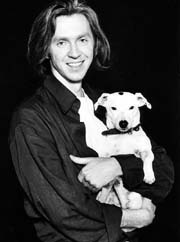
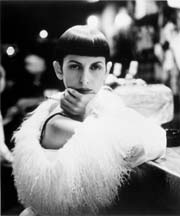
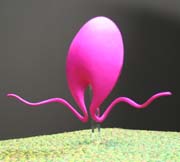
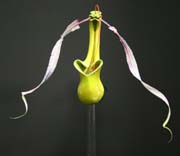
From top: Philip Treacy with Mr Pig. Isabella Blow, photographed
by Steven Meisel. hair by Neil Moody (copyright to Mr Meisel). Shocking
Pink Roswell Hat, 1998. Orchid hat, 1999.
Shocking Pink Roswell Hat (1998), in Lycra,
is meant to evoke aliens, just not in the grey colour that science
fiction films show them in. An orchid hat, made the
same year, is a favourite of Loveday. In 2003, a “Warhol
collection” used pop art, with one hat showing an image of
Marilyn Monroe. Another, in an update, has David Beckham. Treacy
is to millinery as Dali was to art
|

